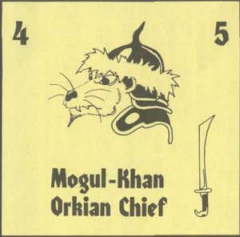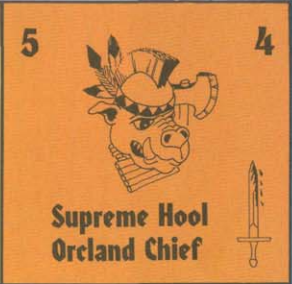These are problematic facets in GAZ10: (Note: "PG" refers to the
Players' Guide; "DMG" refers to the
DM's Booklet.)
#1: The racial slur "yellow" is used to refer to fantasy Asian human beings.
"Akkila-Khan went past the mountains and found King Loark. Together, they ravaged the yellow mens' steppes." PG, p.1
"Yellow Loonies" -label from "The World According to Orcs" map
Both of these "yellow" terms are referring to the Mongolian-inspired human beings of Ethengar. Though spoken from a "stupid/comedic" orcish perspective, they're still racial slurs.
We could look in a 1988 Merriam-Webster dictionary to see whether "yellow man" is considered offensive or not.
***
Imagine if Akkila-Khan and Loark had instead ravaged the African-inspired Serpent Peninsula, and the text had said:
"Together, they ravaged the n*ggers' jungle."
Or imagine of the "The World According to Orcs" map had included the Serpent Peninsula, which had been labeled:
"N*gger Loonies."
That would be a problem; it would not be a "funny" thing which could be "explained away" by saying that the orcs are just stupid.
Please understand that the epithets "yellow man" (and "red man") are commensurate with the n-word.
#2: Misappropriation of "gris-gris", from the Vodun culture of West Africa.
"Then his gri-gri fell into the water and drifted slowly south. The tribe followed." Players' Guide, p.2
"The goblin drops his gri-gri, trinkets, fetiches, and baubles, and drops to the ground. [...] With a final rattle of his gri-gri, the goblin closes his bulging eyes and passes out." -DMB, p.8
See:
Gris-gris (talisman) - Wikipedia
Clarifying note: I'm not enough of a cultural expert in Vodun culture to discern whether the term "gris-gris" could be respectfully adapted for use in a fantasy work; yet the context of this usage in GAZ10 is buffoonish and comedic, which is problematic.
#3: The use of the term "yellow orc" and "Yellow Orkia" to refer to an East Asian (Mongolian/Chinese/Tibetan/Bhutanese)-inspired orcish culture. The basis for the term "yellow orc" is clearly "yellow man", which is an offensive racial slur in present-day English.
See:
yellow man - Wiktionary
Quotes:
"Akkila-Khan's son's parted and formed two tribes: Hobgobland and Yellow Orkia, on the east side of the Broken Lands." PG, p.2
"Yellow Orkia
[...] It is ruled by Moghul-Khan, orcish rival of Hutai-Khan the Hobgoblin." PG, p.12
"Moghul-Khan is the head of an eleven-horde strong army. Each is commanded by a high level yellow orc[.]" PG, p.13
Note the Mongolian cultural motifs ("moghul, khan, horde") in connection with the yellow orcs.
The army of Yellow Orkia includes an "
orientalis" subspecies of goblin:
"Storm Raiders: [...] 60 goblins of the orientalis sort[.]"
"Seven Warlords: [...] 40 orientalis goblins[.]"
"Moghul's Guards: [...] 40 orientalis goblins[.]" PG, p.13
"Goblinus Oriensis: Yellow skin. [...] Often wear [...] large, round, slightly conical hats. Ethengarian* nomads essentially." PG, p.18
*Explanatory note: Ethengarian humans are the primary Mongolian analogue in the Known World of Mystara.
"Yellow Orkians [...] worship Karaash whom they call Hong-Tzu[.] Wogar is also worshipped here as Wong-Ah." PG, p.13
Note: the Yellow Orcs refer to their Immortals with Chinese-style names.
"Yellow Orc:
"Another sub-race of the orcs, identifiable by their dull yellow hides. Some come with ugly rat or pekingese* faces." PG, p.31
*Note: "pekingese" is a breed of dog which originated in China. The breed is named after the Chinese capital city of Peking, now known as Beijing.
See:
Pekingese - Wikipedia
"Orcus Canis Oriensis [=Eastern Dog Orc]: [...] Pekingese face. Favor mismatched pieces of oriental armor[.] Nomads of the vast Ethengarian* steppes, and Yellow Orkia[.]" PG, p.31
*Note: the Ethengarian steppes are an analog of the Mongolian steppes.
"Traditional Humanoid Skills: [...]
"Yellow Orc: Martial Arts" PG, p.34
"Naming Your Character:[...]
"Ethengarian Origins:
"These names are often found in Yellow Orkian and Hobgobland Tribes. Names with a vaguely Mongol ring will do fine here.
"Adja, Adjumuk, Akkila, Altai, Altan, Bajan'uul, Barzoi, Bator, Bulgan, Buzuk, Chumbar, Daiga, Davasuren, Dzagad'hai, Dzubokai, Dzulagazai, Dzuunbulag, Gandgiz, Gegyai*, Gogol, Gunjiz, Gurvan'char, Gyangze*, Gyarduk, Hargul, Hutai, Jamsuren, Jigme** , Kai, Kai-bataar, Kailar, Kazukh, Khampa*, Kitar, Kublai, Lhaze*, Mangpo, Mugluk, Mugul, Muludzin, Namgyal*, Ngarang, Norbor, Olodzin, Oyun, Paryang, Sagyar, Sukhe, Talai, Tzeluk, Tsomo, Udbal, Ulaantar, Ulgarai, Ulmuk'hai, Urumdul, Uzuk, Wu'hai+, Xigaze*, Yagrai, Yarlung*, Zhongbai.+" -PG, p.41
*Note: some of the names are Tibetan in origin; for example:
Gegyai:
Gê'gyai County - Wikipedia
Gyangze:
Gyantse - Wikipedia
Khampa:
Khampa - Wikipedia
Lhaze:
Lhatse County - Wikipedia
Namgyal:
Namgyal - Wikipedia
Xigaze:
Shigatse - Wikipedia
Yarlung:
Yarlung - Wikipedia
**Jigme appears to be of Dzonkha (Bhutanese) origin. Many Bhutanese historical figures are named "Jigme", for example:
Jigme Chhoeda - Wikipedia
+Some names appear to be of Chinese origin:
Wuhai is the Chinese name for a city in Inner Mongolia, China:
Wuhai - Wikipedia
Zhongbai
"Yellow Orkians and Hobgolanders call their horde chiefs 'Khan,' and their tribal chief 'Aga Khan. In a conversation, they simply add '-Khan' after the chief's name." -PG, p.41
See:
Aga Khan - Wikipedia
Hobgobland is also a Mongolian-themed culture. Of the Khan of Hobgobland, it is said:
"Hutai is a middle-aged hobgoblin with Asian features." -DMB, p.12
Of the Khan of Yellow Orkia, it is said:
"[Ethengarian] nomads he has been stalking in the past years call him the Yellow Demon[.]" -DMB, p.14
Here's the illustration of Mogul-Khan from GAZ10's Orc Wars! boardgame:

Note: This character specifically has a yellow-colored playing piece to match his "yellow orc" identity; whereas other playing pieces are of other colors (purple, blue, green).
#4: Misappropriation of the honored Lakota leader Tȟatȟáŋka Íyotake "Sitting Bull", in the form of "Big Chief Sitting Drool."
See:
Sitting Bull - Wikipedia
Quotes:
"Among the greatest chiefs were Queen Udbala and Big Chief Sitting Drool. [...] Later Big Chief Sitting Drool united the tribes again. A new menace was rising to the south. Humans built a city at the gates of our sacred lands, surely a menace to our tribes. Sitting Drool besieged the city, ransacked it, took many slaves, and massacred human armies that followed him into the hills. These were great years.
"Later he was captured, but humans could not keep him long. They let him go for a small price: a few slaves. They had a treacherous plan. He was assassinated by human adventurers shortly after his departure, a deed they will pay for." PG, p.2
Note: In real life, Sitting Bull was "captured" by U.S. forces multiple times, and interned as a prisoner of war. The final U.S. plan to "capture" Sitting Bull resulted in his assassination.
Chronology:
"500 AC: Big Chief Sitting Drool unites Broken Lands."
"523 AC: Big Chief Sitting Drool ransacks Corunglain."
"525 AC: Third Punitive Expedition from Glantri and Darokin. Sitting Drool brought back in chains."
"526 AC: Sitting Drool traded for slaves and gold[.]"
"527 AC: Adventurers assassinate Sitting Drool."
-DMB p.4
#5: The use of the term "red orc" and "Red Orcland" to refer to an American Indian-inspired orcish culture. The basis for the term "red orc" is clearly "red man" or "redskin", both of which are offensive racial slurs in present-day English:
See:

en.wiktionary.org

en.wiktionary.org
Quotes:
"Red Orcland:
[...] Orclanders are similar to Atruaghin Clans*, wearing feathers on their heads, and fighting with arrows and hatchets." PG, p.10
"The old Atruaghin* faith of the Orclanders has been supplanted by other races' religions after being invaded several times after the fall of Sitting Drool." PG, p.11
*Explanatory note: the humans of the Atruaghin Clans are Known World of Mystara's main Indigenous North American cultural analog.
The Red Orcland army is equipped with American Indian style weaponry:
"War Hordes: [...] 75 orcs with bows and axes [...] 30 goblins with hatchets [.]" PG, p.10
"Red Orc:
"This is a sub-race of the orcs, recognizable by their generally red hides and simian features." p.18
Note the term "red hides," which is similar to "redskins." The "Oriental Goblins" (see above) are likewise said to have "yellow skin" and the "Yellow Orcs" are said to have "yellow hides."
"Orcus Rubeus Vulgaris [=Common Red Orc] [...] Simian features emulating many of the various monkey faces found in nature. [...] Southern Red Orcland natives[.]" p.31
"Orcus Simius Terribilis [=Terrible Simian Orc] Natives of northern Red Orcland[.]" -PG
, p.31
There's also an American Indian-themed kobold sub-race:
"Canis Minor Numerus [=Small Number Dogs] [...] Often wear war paints and colorful plumes on their heads as tribal markings. Nomadic culture native of Atruaghin." -PG, p.18
"Traditional Humanoid Skills: [...]
"Red Orc: Outdoor Stealth" -PG, p.34
"Naming Your Character: [...]
"Atruaghin Origins:
"These names are more commonly used by Red Orcland hordes. Red orcs are usually named according to circumstances at their birth. They sound more like American Indian names, although cruder and certainly grosser as befits orcs:
B
ag-Cheek, Bone-Fist, Black-Blood, Broken-Fang, Cave-Hop, Dirt-Ball, Double-Tongue, Fat-Pot, Flat-Skull, Flat-Foot, Flea-Bag, Fork-Chin, Gloom-Mud, Crim-Claw, Gut-Worm, Hare-Snout, Iron-Butt, Little-Big-Snout*, Muck-Bag, Nose-Pick, One-Eye, Ooze-Lip, Pimple-Drip, Pus-Pop, Rattle-Bone, Red-Eye, Red-Hand, Red-Stone, Rot-Finger, Scare-Belly, Scar-Snout, Sitting-Drool*, Skunk-Hide, Slime-Tongue, Stale-Water, Stink-Puff, Stomp-Foot, Stutter-Bug, Two-Feathers, Wart-Bag, Wolf-Head, Wood-Hand, Yellow-Dust, Yawning-Bear, Zorn-Breath.
"Red Orclanders call their tribal chief 'Big Chief.'" PG, p.41
*Note: "Little-Big-Snout" is an appropriation of "Little Bighorn", a sacred site:
Battle of the Little Bighorn - Wikipedia. The name "Little Bighorn" is a translation of an Apsáalooke (Crow) name for the Little Bighorn River:
Iisaxpúatahcheeaashiakaate "Little Bighorn (Sheep) River."
"Sitting-Drool" is an appropriation of
Tȟatȟáŋka Íyotake "Sitting Bull."
Hool is the Big Chief of Red Orcland:
"Hool: Supreme of Orcland:
"Hool is a tall Orcus Simius Terribilis [Terrible Simian Orc] with long, red, shaggy hair which he wears braided with feathers. A magical headband +2, stolen from an Atruaghin brave, improves his Armor Class and Saving Throws[.] [...] Hool is easy to recognize with his facial paints (his face is black from the eyes up). When needed, Hool will use an ornately carved hatchet to fight[.]" -DMB, p.12
Here's the illustration of Hool, from GAZ10's Orc Wars! boardgame:

Note the mohawk, feathered headband, hatchet, and American Indian-style breastplate. And, this character has a red-colored playing piece to match his "red orc" identity.
#6: A "notorious" misappropriation of the name of the Nakota (Assiniboine/Stoney) nation.
"A deserted plateau called Nakota's Grave, covers central Red Orcland between two mountain ranges. Nakota's Grave is notorious for being the red orcs' sacred burial grounds[.]" PG, p.10
See:
Nakota - Wikipedia
#7: Insensitive reference to the phrase: "The Only Good Indian Is a Dead Indian".
For a scholarly study of this "proverb", see:
"The Only Good Indian Is a Dead Indian": History and Meaning of a Proverbial Stereotype on JSTOR
Quote:
"The golden rule: A Good Orc is a Dead Orc." PG, p.30 (spoken by a human caravan guard)






